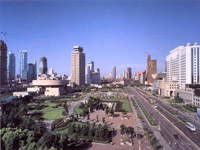Microfinance in China is poised for a significant expansion as the government, Non-governmental Organizations (NGOs) and commercial banks begin to explore ways to provide the country’s most impoverished people with greater access to credit.
According to Bai Chengyu, secretary general of the China Association of Microfinance, after 10 years of development, microcredit has entered a transition phase and is now moving “from experiment to large-scale commercial development.”
Microcredit has a long history in Asia, dating back to 1976 when the Grameen Bank in Bangladesh began providing small loans primarily to women in small groups, a segment of society too poor to qualify for credit from the banks. It started in China in the mid-1990s, when the United Nations Development Program (UNDP) and the World Bank began promoting the concept in cooperation with Chinese organizations.
Microfinance may include several types of financial services, including deposit taking and insurance, while microcredit normally refers to small loans of between 1,000 yuan and 3,000 yuan ($125-$375). The terms are often used interchangeably in the media.
Many are hoping that microfinance can give a boost to rural China, which today faces enormous problems. Some 30 million “relatively” poor people survive on less than one dollar a day, and another 30 million people live in “absolute poverty” of less than 25 cents a day. The vast majority of these are in the countryside, where there is a huge gap in living conditions and public services, such as medical care and education, compared to urban areas.
A World Bank report last October argued that there was a strong link between weak access to credit and low incomes. People involved in microfinance say that a small loan of $100 to buy animals or seeds for planting can make a major difference for a poor family, and a series of loans within a community can transform it.
Low Sustainability
But despite its successes, the microfinance sector is facing problems in China. “Although the payment rate is very high in some microfinance institutions (MFIs), most are not running efficiently,” says Bai. Nor is this trend unique to China. According to the United Nations Capital Development Fund, just 1% of MFIs around the world are financially stable, and China is no different. Sarah Tsien, a consultant with IPC, an affiliate of ProCredit in Germany, puts it more strongly: “Microfinance has been quite a disaster in China. Overall, it never achieved a scale of sustainability.”
One such example is the Tianjin Women’s Federation, whose program seemed to get off to a good start, only to later stagnate. “Tianjin is a big city but the Federation reached less than 2,000 clients after more than seven years,” says one analyst. “It should have been 30,000.”
Bai says the major bottleneck to the commercialization of microlending is the lack of policies to encourage involvement by commercial financial institutions, the failure to open the financial market to the private sector, artificially low interest rates and the lack of a legal environment. Experts agree that the future of microcredit and microfinance requires strong cooperation between banks that can provide capital and grassroots organizations that reach down to the village level where China’s poorest people live.
ProCredit, an NGO which has 19 banks around the world involved in microfinancing, believes the sector needs to be more professional. “When it comes to providing financial services, you need to have people who know how to take a commercial approach and who know how to be bankers,” says Tsien.
But despite claimed low default rates and potentially high yields, commercial banks are not yet convinced that there’s money to be made in this sector. The main problem is that borrowers are often located in far flung parts of the country, which means sending loan officers into remote areas to consider credit for people often asking for only about $120. And if the bankers grant the loan, they have to find a way to disburse the funds and then secure repayment.
Microfinance organizations say that interest rates must be raised to make lending more feasible. Most MFIs are currently charging rates that are only slightly higher than commercial banks, albeit much lower than loan sharks, who charge a hefty 3% monthly interest. Kong Xiangyi, a professor at the Shanxi University of Finance and Economics, told Reuters in April that peasants turn to illegal lenders for 50% or more of their borrowing needs.
The China Foundation for Poverty Alleviation (CFPA), a Chinese government-affiliated NGO which charges in a range of 7% to 9%, a bit higher than the Rural Credit Cooperative (RCC), says it plans to raise its rates in the near future to the higher end of the scale. The trick is to charge a rate that is high enough to make lending efficient, but not so high that it excludes the poor.
Li Qi, a program officer in the microfinance department of CFPA, says the market can bear the higher rates. CFPA’s clients, she notes, are different than RCC’s. “The better clients apply for RCC loans, which are more favorable.” While her organization normally requires payment on a monthly basis, the RCC has more long-term repayment schemes. “Our clients are poor and have no choice,” Li notes. “Before getting money from us, they had to go to money lenders, and the interest rate was quite high.”
More Private Sector Involvement
While ProCredit actually runs banks in 19 different countries, restrictions don’t allow this in China, and so the organization is focusing on consulting, as well as encouraging the City Commercial Bank system to get involved in microfinance. PlaNet Finance, an NGO, is providing training in accounting, loan management and risk analysis.
The World Bank report also pointed to this new trend. “While most microfinance programs have been funded by governments and donors, efforts are now shifting to fostering commercial microfinance institutions,” the report said. “Improving the environment for microfinance can also extend more credit to the rural poor.”
NGOs, including PlaNet Finance, ProCredit and CPAF, are making an effort to increase private sector activity. “Why did we get involved in this in the first place?” asks Gabrielle Harris, executive director of PlaNet Finance China. “It’s because the banks were not willing to lend to people without collateral, and poor people in rural areas had no access to credit.” To get city commercial banks and rural credit cooperatives involved, organizations like PlaNet Finance will have to first build up trust and convince banks that microfinance is a legitimate business with worthwhile returns. “It’s not going to happen at the emotional level,” she says, adding that her job is to convince local banks that NGOs have a good track record and that there is a potential for good partnerships.
As Chinese regulations keep foreign banks out of direct involvement in the microfinance market, ProCredit is trying to set up relationships with the City Commercial Banks — part of China’s old urban credit collectives which, a few years ago, were reorganized into city commercial banks and now exist in some 30 cities — to build up microfinancing services. It has done this in 10 other countries.
Tsien says that with bankers reluctant to travel into the countryside to approve and disburse loans, which would entail high transportation and communication costs, ProCredit plans to first focus on cities, later spreading into rural areas. Loans will be higher than the norm in microcredit, running between 5,000 to 10,000 yuan ($625-$1,250). Her job will be convincing local banks to jump into the microfinance market, when many may not be interested. ProCredit will choose an initial 12 out of 130 City Commercial Banks to cooperate with. “We are trying to retrain loan officers to go out with a calculator and figure out what a micro-entrepreneur can pay, and to put less emphasis on the role of collateral.” Experience around the world shows that collateral isn’t necessary, she says, conceding, however, that the argument “will make bankers nervous.”
The Grameen Bank Example
People involved in microcredit argue that the repayment rates are high, and even better than those of major world banks in wealthy countries. They attribute this to the model borrowed from Grameen Bank in Bangladesh. Grameen’s borrowers were very poor, with incomes of less than $1 per day. As there was no collateral, and obviously no credit history in the beginning, borrowers were set up in groups that had to monitor one another, and apply soft, or peer, pressure to guarantee that loans were repaid. As loans were paid back, borrowers could qualify for bigger loans, which was an added incentive.
The CFPA has successfully adopted the Bangladesh model, according to Li, who claims about a one percentage point of bad loans and an overdue rate of 1.79 for all its areas. A loan is considered overdue when it’s one day late, and a loan that is not paid for one year is considered a bad debt. Borrowers are members of guaranty groups made up of five to seven individuals, and if one member of the group cannot pay, the others will have to make the payment for him or her. “It’s a kind of peer pressure,” she says. “The client will say, ‘If I’m overdue, the whole village will know.'”
Financial experts express doubts about the statistics concerning bad loans, arguing that current lenders are primarily governments, NGOs and philanthropists who may be slow to declare a loan as unretrievable.
Most loans are also directed to women, who are seen as a better risk than men. CFPA says 40% of its existing loans have gone to women, and that new projects will focus primarily on them. “It’s because women are more reliable,” says Li. “They manage money very well and they seldom go out to do migrant work or gamble or drink. And [getting a loan] can change their position in the family and empower them.”
Enter Citigroup, HSBC and Others
Local commercial and rural banks may soon find themselves being nudged into the sector as competition builds up around China. There are examples of success in other countries to follow. After BRI, an ailing state rural lender in Indonesia, flopped in 1984, it was changed into a bank for the poor, providing loans and also government-backed savings programs with no minimum deposit. Today it has some 30 million savings accounts. More interesting, some of the world’s biggest lenders are also getting involved, including ABN Amro, HSBC, ING and Citigroup. Citigroup gave $1.3 million to Grameen USA/Trust between 2001 and 2003 to support microfinance programs in China for 25,000 impoverished families.
Robert Annibale, global director for Citigroup Microfinance, says he’s been impressed by the credit performance, profitability and depth of client outreach to under-served communities that MFIs have demonstrated. “The challenge is to manage costs for relatively high volume, small notional size loans,” he says. “However, there are models and institutions that make such a proposition commercially attractive and scalable.”
Annibale points to the example of other countries, where cooperatives, credit unions and post office banks have led the way in microfinance. “China will no doubt find its own path,” he says, “but there is a diverse history of very sustainable and even profitable microloan portfolios, particularly in Asia and Latin America.”
With rural conditions becoming a major concern, some observers are hoping that the government will pay more attention to the problem of alleviating poverty via microfinance. The head of one Western NGO involved in microfinancing described rural areas as “untenable,” adding that she felt rural citizens had been “abandoned” by the government. She said, however, that she felt that the Hu Jintao government was committed to doing something to improve the situation in the countryside.
Indeed, the government is already taking steps to promote the use of microfinance. Chen Yuan, governor general of the China Development Bank (CDB), has said that he would like to have microfinance available in every province of China — through the CDB — by 2010. “The government is trying to reduce the poverty level” says Li, “and it thinks that microfinance is a good way to help.”
The People’s Bank of China (PBOC) recently launched a special policy research team to study the development of microfinance. The government has also allocated funds to absorb some of the risk in lending to poor people, aimed at encouraging participation by financial institutions. Furthermore, the government says it is reducing its own role, hoping to make the sector more market oriented. Finally, at the end of last year, pilot projects were launched in five provinces allowing financing by private businesses.
Training Courses for MFIs
The private sector and NGOs are now focusing on hardware to improve the efficiency of microcredit. The Citigroup Foundation-funded China Microfinance Training Center has provided training courses for MFIs in China. It has also given a $1.5 million grant to the Chinese Academy of Social Sciences to provide training and better support services for China’s microfinance sector. The training center will train more than 1,000 management and staff from MFIs by the year 2009. The courses will include microfinance product development, marketing, risk management and internal control, operations and financial management.
Beginning in September 2005, CFPA, which gets capital from the government and from donors, took advantage of a reform of the regulations governing NGOs to turn its grassroots MFIs into legal CFPA branches, making them directly responsible to the headquarters in Beijing. It currently has five microfinance branches, a lending fund of 20 million yuan, and more than 15,000 active clients. And two new counties will soon be added, one in Hubei and one in Hebei provinces. The organization is hoping to streamline its own operations and raise interest rates to a level that will make it possible to become sustainable through revenue.
If the government, banks, MFIs and NGOs can begin to work together, microcredit could have a major impact on poverty in China’s rural areas. This growing interest in the sector was highlighted in March, when the Asia Microfinance Forum was held in Beijing, attracting more than 280 participants from more than 20 countries, including representatives from MFIs, central banks, commercial banks and even the private sector. The forum focused on how these various agencies could form partnerships to improve the environment for microfinance.
The four-day forum, co-sponsored by the Citigroup Foundation, showcased several good examples of how microfinance is changing impoverished areas. For example, in the Philippines, a telecom company turned mobile phones into electronic wallets that enable low income Filipinos to handle remittances, deposits, loan payments, bill payments and other financial transactions through simple text messaging. Another project introduced to participants was the Hatton National Bank in Sri Lanka, which formed a partnership with the postal service so that post offices could offer electronic banking services for microfinance customers in far-flung areas.
The forum also sought to make participants aware of the various strengths that each brings to the table. It was emphasized that NGOs had to conduct microfinance operations on a more commercial basis, and that commercial banks needed to understand the expertise that MFIs have in reaching impoverished people in both inner-city slums and rural areas.



